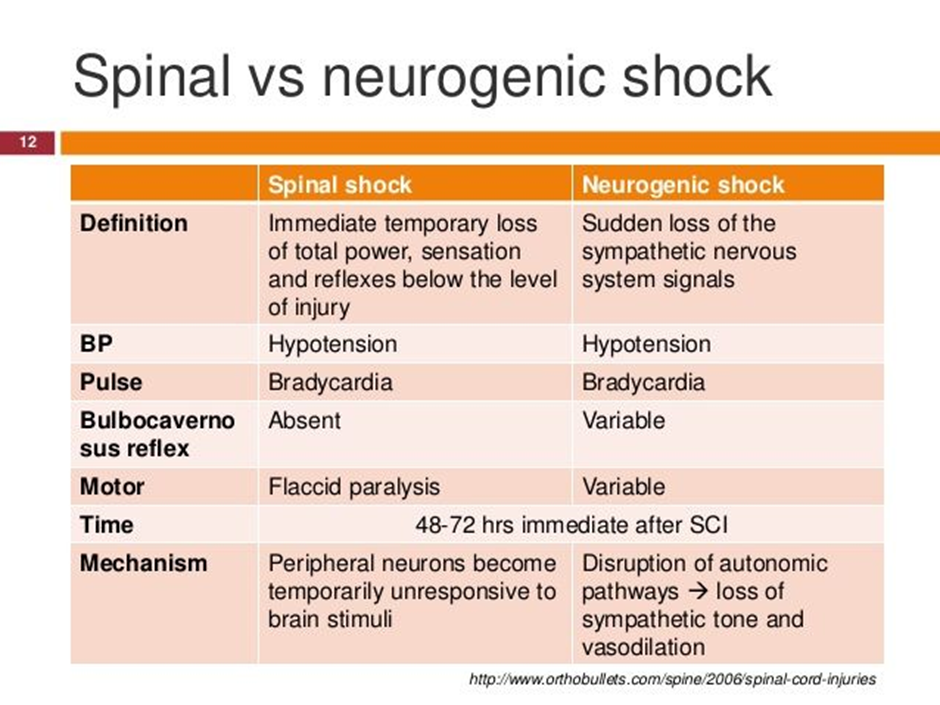A nurse is assessing a client who has a spinal cord injury. Which of the following assessment findings should the nurse expect with neurogenic shock? (Select all that apply.)
(Select All that Apply.)
Temperature 36.3° C (97.4° F)
Respirations 12/min
Blood pressure 184/88 mm Hg
Heart rate 54/min
Calcium level 7.0 mg/dL
Correct Answer : A,D
Choice A Reason:
Temperature 36.3°C (97.4°F) is correct. Hypothermia is a characteristic finding in neurogenic shock due to the loss of sympathetic control over temperature regulation and peripheral vasodilation. This can lead to heat loss from the skin surface and a decrease in core body temperature.
Choice B Reason:
Respirations 12/min is incorrect. Respiratory rate is usually not significantly affected in neurogenic shock. However, individuals with high cervical or upper thoracic spinal cord injuries may experience respiratory compromise due to paralysis of respiratory muscles, but this is not a typical feature of neurogenic shock.
Choice C Reason:
Incorrect: Neurogenic shock typically results in hypotension (low blood pressure) due to vasodilation. The given blood pressure reading is elevated, which is not consistent with neurogenic shock.
Choice D Reason:
Heart rate 54/min is correct. Bradycardia is a common finding in neurogenic shock due to unopposed parasympathetic activity resulting from the loss of sympathetic tone. The heart rate may be slow and may decrease further over time.
Choice E Reason:
Calcium level 7.0 mg/dL is incorrect, Calcium levels are not directly related to neurogenic shock. Neurogenic shock primarily involves the loss of sympathetic tone and the resulting hemodynamic changes, rather than alterations in calcium metabolism.
Nursing Test Bank
Naxlex Comprehensive Predictor Exams
Related Questions
Correct Answer is C
Explanation
Choice A Reason:
Air cannot pass freely into the thoracic cavity through a chest wound is incorrect because air can indeed pass freely into the thoracic cavity through the chest wound in an open pneumothorax.
Choice B Reason:
The air is trapped when it enters the cavity is incorrect because the characteristic feature of an open pneumothorax is that air is not trapped; rather, it enters the thoracic cavity with each inhalation and exits with each exhalation through the chest wound.
Choice C Reason:
Air moves in and out of a wound in the chest wall is correct. In an open pneumothorax, also known as a "sucking chest wound," air can freely move in and out of the thoracic cavity through a wound in the chest wall. This occurs due to the creation of a communication pathway between the external environment and the pleural space, typically caused by a penetrating injury to the chest.
Choice D Reason:
There are no audible sounds in an open pneumothorax is incorrect because in an open pneumothorax, there may be audible sounds associated with the movement of air in and out of the wound, such as a sucking or bubbling sound, depending on the size and location of the wound. These sounds can be clinically significant and aid in the diagnosis of an open pneumothorax.
Correct Answer is ["B","D","E"]
Explanation
Choice A Reason:
Metoprolol is incorrect. Metoprolol is a beta-blocker medication commonly used to treat conditions such as hypertension, angina, and heart failure. However, in the context of neurogenic shock following a spinal cord injury, the use of beta-blockers such as metoprolol is generally contraindicated. Beta-blockers antagonize the effects of sympathetic activation, leading to a reduction in heart rate and myocardial contractility, which can exacerbate hypotension and bradycardia, the hallmarks of neurogenic shock. Therefore, the nurse would not anticipate a prescription for metoprolol in the management of neurogenic shock.
Choice B Reason:
Lactated Ringers intravenous fluid is correct. Fluid resuscitation with isotonic crystalloid solutions such as lactated Ringers is essential to restore intravascular volume and improve perfusion.
Choice C Reason:
Furosemide is incorrect. Furosemide is a loop diuretic medication commonly used to treat conditions such as heart failure, edema, and hypertension by promoting diuresis and reducing fluid volume. However, in the context of neurogenic shock, the use of diuretics such as furosemide is generally not indicated unless there is concurrent volume overload. Neurogenic shock is characterized by hypotension due to vasodilation and decreased systemic vascular resistance, often leading to relative hypovolemia rather than volume overload. Therefore, administering furosemide could further decrease intravascular volume, exacerbating hypotension and compromising perfusion. As a result, the nurse would not anticipate a prescription for furosemide in the management of neurogenic shock.:
Choice D Reason:
Dopamine is correct. Dopamine is a vasopressor medication that acts to increase vascular tone and blood pressure by stimulating alpha-adrenergic receptors. It is commonly used in the management of neurogenic shock to augment blood pressure.
Choice E Reason:
Epinephrine is correct. Epinephrine is a potent vasopressor that acts on both alpha and beta-adrenergic receptors, leading to vasoconstriction and increased cardiac output. It is used in the treatment of refractory hypotension in neurogenic shock.

Whether you are a student looking to ace your exams or a practicing nurse seeking to enhance your expertise , our nursing education contents will empower you with the confidence and competence to make a difference in the lives of patients and become a respected leader in the healthcare field.
Visit Naxlex, invest in your future and unlock endless possibilities with our unparalleled nursing education contents today
Report Wrong Answer on the Current Question
Do you disagree with the answer? If yes, what is your expected answer? Explain.
Kindly be descriptive with the issue you are facing.
